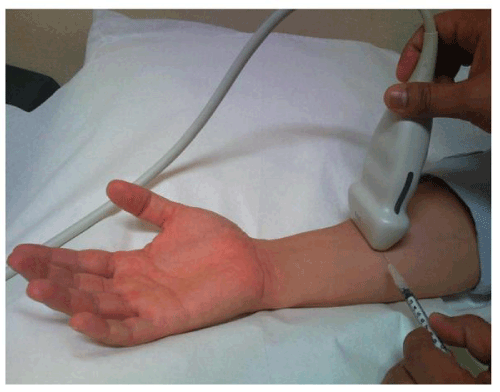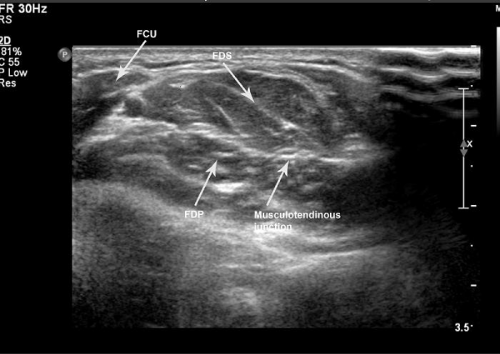|
|
| Rajat Goel* |
| Department of Surgery, Minimally Invasive Surgical Centre, National University Hospital, Singapore, Singapore |
| *Corresponding authors: |
Rajat Goel
MBBS, MS, DNB, Department of Surgery
Minimally Invasive Surgical Centre
National University Hospital, Singapore
E-mail: goelrajat27@gmail.com |
|
| |
| Received March 29, 2012; Published July 16, 2012 |
| |
| Citation: Goel R (2012) Treatment of Musician’s Dystonia with the Use of Ultrasound- Guided Injection of Botox: An Interesting Case Report. 1: 220. doi:10.4172/scientificreports.220 |
| |
| Copyright: © 2012 Goel R. This is an open-access article distributed under the terms of the Creative Commons Attribution License, which permits unrestricted use, distribution, and reproduction in any medium, provided the original author and source are credited. |
| |
| Abstract |
| |
| Dystonia is a movement disorder that causes muscles to contract and spasm involuntarily. Dystonia in musicians is a task specific movement disorder that occurs when musician is playing the instrument. It is highly disabling and causes lot of psychological trauma to the musician in addition to professional embarrassment. We present here a case report of patient with musician’s cramp successfully treated with Botulinum Toxin Type A injection under Ultrasound guidance. |
| |
| Keywords |
| |
| Botox; Dystonia; Musician’s Hand; Injection; Ultrasound |
| |
| Introduction |
| |
| Focal Dystonia (FD) in musicians, also known as musician’s cramp or musician’s dystonia, is a task specific movement disorder. ‘Focal’ refers to symptoms being located to one particular location, hand in this particular case and ‘task specific’ means symptoms occur only when individual engages in particular activity, playing an instrument by musician in this case. 1% of all professional musicians are affected by it [1,2]. The recognition of this entity is late as both musicians and surgeons initially consider it as a variant of normal or an excuse to underperformance by musician and can lead to lot of psychological trauma to the professional music players. The best modality of treatment of above condition is early recognition and prevention. Lots of treatment options have been tried for it ranging from anticholinergic agents, sensorimotor retraining, splinting and immobilization, thalamotomy of the ventralis oralis anterior thalamus and Botox (botulinum toxin type A). We present a case report of patient treated successfully with Botulinum toxin injection. |
| |
| Case Report |
| |
| A 34-year-old male left hand dominant playing piano for past 20 years presented to us with progressive stiffness and weakness of right hand ring and little fingers for one and half years. The patient used to develop excessive flexion of the ring and little fingers of the right hand 10-15 minutes in to the performance which later progressed that he could not play the instrument at all at the time of presentation. The patient had tried oral medications with no effect. The patient had already received a trial of blind injection of Botulinum Toxin Type A elsewhere and developed finger drop and profound weakness involving ring, little and middle fingers. He came to us 2 months later. When he presented to us, he was assessed to be stage 0 (Table 1) on Dystonia evaluation scale by Tubiana [3]. On examination the patient had good range of motion and normal grip strength. This time patient received Botulinum toxin Type A injection under Ultrasoundguidance directed at musculotendinous junction of the Flexor Digitorium Profundus (FDP) (Figure 1) of the ring and little fingers. Initially the patient developed paralysis of ring and little fingers of the right hand without affecting the other fingers. Slowly the ring and little fingers recovered and showed improvement and after 1 month post injection, he was able to resume full concert performances. The Dystonia evaluation scale for the patient subsequently improved to 5 (Table 1). He is currently on follow up past 2 years with no relapse. |
| |
|
|
Table 1: Dystonia Evaluation Scale [2]. |
|
| |
|
|
| |
| Discussion |
| |
| Focal dystonia in musicians is a difficult condition to treat. The current understanding of the pathophysiology of dystonia is limited. Structural and functional abnormalities of the basal ganglia and their pathways have been found. Dystonia may be associated with lack of inhibition at multiple levels of nervous system, increased neural plasticity, and an abnormal sensory processing [4]. So a variety of treatment strategies have been tried ranging from oral medications like anticholinergic drugs, sensorimotor retraining, splinting and immobilization, thalamotomy of the ventralis oralis anterior thalamus and Botox (botulinum toxin type A). The therapeutic effect of botulinum toxin type A is primarily through its action of blocking release of acetylcholine in to the neuromuscular junction causing local temporary chemodenervation and paralysis [5]. Recent investigations suggest that Botulinum toxin exerts its effect both peripherally and possibly centrally [6-8]. So once the musicians develop the condition, the challenge for the physician is to determine which is the best modality of treatment -pharmaceutical, neuroretraining, surgery or a combination of the above. Treatment with Ultrasound guided Botox injection is an attractive and relatively safe alternative. The procedure can be done outpatient (Figure 2) where the forearm muscles as in our case can be identified and the involved muscle targeted on Ultrasound at musculotendinous junction as shown (Figure 1). Localization of botulinum toxin can be achieved with palpation under stretch, active EMG, USG (in our case) or combination of above. The initial doses are 5 U for small muscles and 10-20 U for muscles in forearm, large doses into a single muscle are best given in multiple sites to aid diffusion of the Botox [9]. Patients should understand that the injections provide symptomatic relief and not cure. The injection should be injected by a highly skilled physician who is well-versed in handling the ultrasound machine and a good knowledge of ultrasound anatomy. The injection should be targeted to the affected muscle group at the musculotendinous junction, these criteria are met, then ultrasound becomes a relatively cheap, safe and attractive option. The patient must also understand that it may take three or four injection cycles (approximately 1 year) to arrive at a pattern that is maximally beneficial. The patient may experience mild weakness for about 4 weeks after the injection, but then enjoy greater benefit once the weakness dissipates and the clinical benefit remains. The patient should also bear in mind side effects of Botulinum Toxin Type A like persistent weakness of the injected muscles, weakness of wrong muscle group or a local bruise over the site of injection and rarely allergic reactions but these are very rare. . There is no study comparing various treatments options for Musician’s Hand to standardize the treatment. Botox has been successfully tried under electromyography (EMG) in Musician’s Hand with encouraging results with Schuele et al. [10] reporting 58 (69%) out of 84 musicians experiencing improvement and 30 (36%) showing long- term benefit in their performance ability. |
| |
|
|
| |
| Conclusion |
| |
| Till the pathophysiology and treatment options are clearly understood and standardized, Ultrasound-guided Botox remains attractive treatment option for treatment of musician’s dystonia as it can be done as an outpatient procedure, providing symptomatic relief with minimal morbidity. |
| |
| |
| References |
| |
- Altenmüller E (2003) Focal dystonia: advances in brain imaging and understanding of fine motor control in musicians. Hand Clin 19: 523-538.
- Altenmüller E, Jabusch HC (2009) Focal hand dystonia in musicians: phenomenology, etiology, and psychological trigger factors. J Hand Ther 22: 144-154.
- Toledo SD, Nadler SF, Norris RN, Akuthota V, Drake DF, et al. (2004) Sports and performing arts medicine. 5. Issues relating to musicians. Arch Phys Med Rehabil 85: S72-S74.
- Breakefield XO, Blood AJ, Li Y, Hallett M, Hanson PI, et al. (2008) The pathophysiological basis of dystonias. Nat Rev Neurosci 9: 222-234.
- Frucht SJ (2009) Focal task-specific dystonia of the musicians' hand--a practical approach for the clinician. J Hand Ther 22: 136-142.
- Ceballos-Baumann AO, Sheean G, Passingham RE, Marsden CD, Brooks DJ (1997) Botulinum toxin does not reverse the cortical dysfunction associated with writer's cramp. A PET study. Brain 120: 571-582.
- Byrnes ML, Thickbroom GW, Wilson SA, Sacco P, Shipman JM, et al. (1998) The corticomotor representation of upper limb muscles in writer's cramp and changes following botulinum toxin injection. Brain 121: 977-988.
- Gilio F, Currà A, Lorenzano C, Modugno N, Manfredi M, et al. (2000) Effects of botulinum toxin type A on intracortical inhibition in patients with dystonia. Ann Neurol 48: 20-26.
- Ramachandran S (2012) Dystonia Treatment using Botulinum Toxin (Botox R).
- Schuele S, Jabusch HC, Lederman RJ, Altenmüller E (2005) Botulinum toxin injections in the treatment of musician's dystonia. Neurology 64: 341-343.
|
| |
| |


